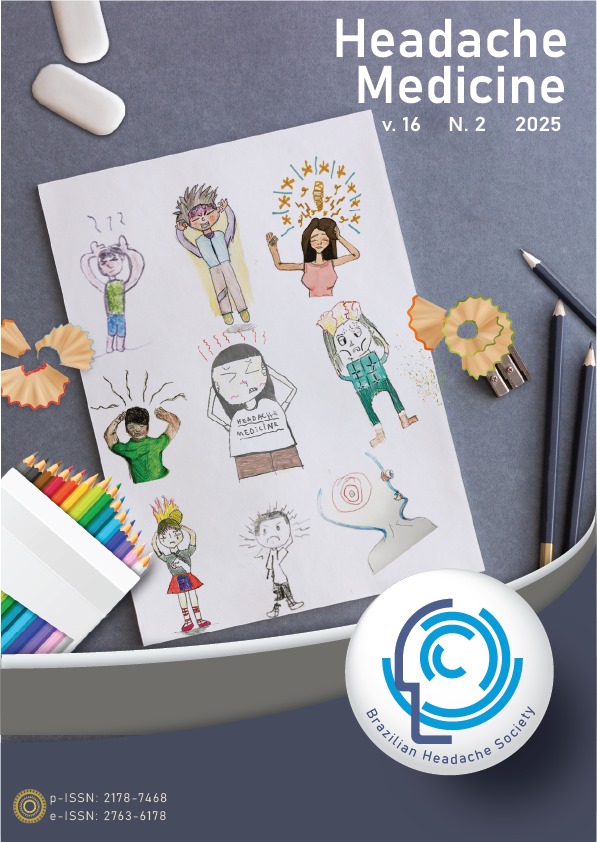Migraine associated with psychosocial factors such as catastrophizing, anxiety and stress
Views: 399DOI:
https://doi.org/10.48208/HeadacheMed.2025.15Palavras-chave:
Migraine, Catastrophizing, Anxiety, StressResumo
Introduction
Migraine is a prevalent and disabling neurological disorder characterized by recurrent episodes of intense headache, often accompanied by nausea, photophobia, and phonophobia. Beyond its neurovascular and genetic nature, migraine is influenced by psychosocial factors that modulate symptom severity and frequency. Among these, pain catastrophizing, anxiety, and stress are highly relevant due to their impact on clinical outcomes and quality of life. This narrative review aims to synthesize the current literature on the influence of these psychosocial factors in migraine.
Methodology
This is a narrative literature review focused on the relationship between migraine and the psychosocial factors pain catastrophizing, anxiety, and stress. A search was conducted in the databases PubMed, Web of Science, and the Virtual Health Library (VHL) using the keywords: “catastrophizing” AND “anxiety” AND “migraine”.
Results
Pain catastrophizing is associated with increased pain intensity, reduced treatment response, and greater disability in individuals with migraine. Anxiety is a prevalent comorbidity that exacerbates symptoms through hyperactivation of limbic circuits. Stress acts as both a trigger and perpetuating factor, particularly in individuals with low adaptive capacity. These three factors interact dynamically, forming a biopsychosocial triad that contributes to migraine chronification and diminished quality of life.
Conclusion
Psychosocial variables significantly influence the course and burden of migraine. Their identification and management through integrative care strategies and public health initiatives are essential to improving clinical outcomes and reducing the societal impact of migraine.
Downloads
Referências
Headache Classification Committee of the International Headache Society (IHS) The International Classification of Headache Disorders, 3rd edition. Cephalalgia 2018;38:1–211. Doi:10.1177/0333102417738202. DOI: https://doi.org/10.1177/0333102417738202
Souza NE, Calumby ML, Afonso EDO, Nogueira TZS, Pereira ABCN da G. Cefaleia: migrânea e qualidade de vida. Revista de Saúde 2016;6:23. Doi:10.21727/rs.v6i2.55. DOI: https://doi.org/10.21727/rs.v6i2.55
Sullivan MJL, Bishop SR, Pivik J. The Pain Catastrophizing Scale: Development and validation. Psychol Assess 1995;7:524–32. Doi:10.1037/1040-3590.7.4.524. DOI: https://doi.org/10.1037//1040-3590.7.4.524
Severeijns R, Vlaeyen JWS, van den Hout MA, Weber WEJ. Pain Catastrophizing Predicts Pain Intensity, Disability, and Psychological Distress Independent of the Level of Physical Impairment. Clin J Pain 2001;17:165–72. Doi:10.1097/00002508-200106000-00009. DOI: https://doi.org/10.1097/00002508-200106000-00009
Edwards RR, Haythornthwaite JA, Sullivan MJ, Fillingim RB. Catastrophizing as a mediator of sex differences in pain: differential effects for daily pain versus laboratory-induced pain. Pain 2004;111:335–41. Doi:10.1016/j.pain.2004.07.012. DOI: https://doi.org/10.1016/j.pain.2004.07.012
Sturgeon JA, Zautra AJ. Psychological Resilience, Pain Catastrophizing, and Positive Emotions: Perspectives on Comprehensive Modeling of Individual Pain Adaptation. Curr Pain Headache Rep 2013;17:317. Doi:10.1007/s11916-012-0317-4. DOI: https://doi.org/10.1007/s11916-012-0317-4
Oliveira DAR dos, Leite AFB, Rocha Filho PAS, Valença MM. Headache catastrophization and its relationship with disability, depression, anxiety, stress and sleep quality. Headache Medicine 2021;12:118–27. Doi:10.48208/HeadacheMed.2021.22. DOI: https://doi.org/10.48208/HeadacheMed.2021.22
Recomendações para o tratamento da crise migranosa. Arq Neuropsiquiatr 2000;58:371–89. Doi:10.1590/S0004-282X2000000200029. DOI: https://doi.org/10.1590/S0004-282X2000000200029
Krymchantowski A V, Jevoux CC. Practical management of headache and craniofacial pai. São Paulo: Lippincott; 2006.
Mercante JPP, Bernik MA, Zukerman-Guendler V, Zukerman E, Kuczynski E, Peres MFP. Comorbidade psiquiátrica diminui a qualidade de vida de pacientes com enxaqueca crônica. Arq Neuropsiquiatr 2007;65:880–4. Doi:10.1590/S0004-282X2007000500031. DOI: https://doi.org/10.1590/S0004-282X2007000500031
Albuquerque AV de, Albuquerque LHM de, Moreira Filho PF. Ansiedade e Depressão em Pacientes Migranosos. Revista Neurociências 2013;21:22–7. Doi:10.34024/rnc.2013.v21.8200. DOI: https://doi.org/10.4181/RNC.2013.21.689.6p
Santos ERR dos, Oliveira DA de, Valença MM. Catastrophization and migraine: a reflection on coping with pain. Headache Medicine 2017:48–54. Doi:10.48208/HeadacheMed.2017.13. DOI: https://doi.org/10.48208/HeadacheMed.2017.13
Margis R, Picon P, Cosner AF, Silveira R de O. Relação entre estressores, estresse e ansiedade. Revista de Psiquiatria Do Rio Grande Do Sul 2003;25:65–74. Doi:10.1590/S0101-81082003000400008. DOI: https://doi.org/10.1590/S0101-81082003000400008
Braga JEF. Pathological anxiety: neural bases and advances in the psychopharmacological approach. Brazilian Journal of Health Sciences 2011;14:93–100. DOI: https://doi.org/10.4034/RBCS.2010.14.02.13
Breslau N, Schultz LR, Stewart WF, Lipton RB, Lucia VC, Welch KMA. Headache and major depression. Neurology 2000;54:308–308. Doi:10.1212/WNL.54.2.308. DOI: https://doi.org/10.1212/WNL.54.2.308
Santos ERR dos. Catastrofização da cefaleia e associação com outras condições clínicas. Doutorado. Universidade Federal de Pernambuco, 2018. DOI: https://doi.org/10.48208/HeadacheMed.2018.8
The International Classification of Headache Disorders, 3rd edition (beta version). Cephalalgia 2013;33:629–808. Doi:10.1177/0333102413485658. DOI: https://doi.org/10.1177/0333102413485658
Mascella V. Stress, sintomas de ansiedade e depressão na migrânea e cefaleia tensional. Mestrado. Pontifícia Universidade Católica, 2011.
Peres MFP, Valença MM, Silva-Neto RP. Management of psychiatric comorbidities in migraine. Headache Medicine 2018:61–7. Doi:10.48208/HeadacheMed.2018.13. DOI: https://doi.org/10.48208/HeadacheMed.2018.13
Zampieri MAJ, Tognola WA, Galego JCB. Patients with chronic headache tend to have more psychological symptoms than those with sporadic episodes of pain. Arq Neuropsiquiatr 2014;72:598–602. Doi:10.1590/0004-282X20140084. DOI: https://doi.org/10.1590/0004-282X20140084
Lipton RB, Bigal ME. Ten Lessons on the Epidemiology of Migraine. Headache: The Journal of Head and Face Pain 2007;47. Doi:10.1111/j.1526-4610.2007.00671.x. DOI: https://doi.org/10.1111/j.1526-4610.2007.00671.x
Bernardi MT, Bussadori SK, Fernandes KPS, Biasotto-Gonzalez DAp. Correlation between stress and tension-type headache. Fisioter Mov 2008;21.
Downloads
- PDF (English) 174
Publicado
Como Citar
Edição
Seção
Licença
Copyright (c) 2025 Erlene Roberta Ribeiro dos Santos, Iris Milleyde da Silva Laurentino, Antonio Flaudiano Bem Leite, Juliana Ramos de Andrade, Marcelo Moraes Valença (Author)

Este trabalho está licenciado sob uma licença Creative Commons Attribution 4.0 International License.










